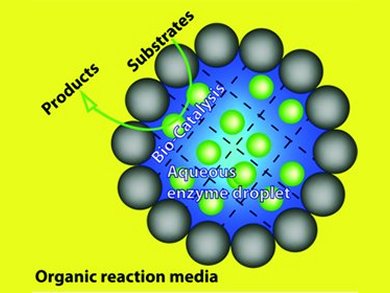Dayang Wang and co-workers, Max Planck Institute of Colloids and Interfaces, Potsdam, Germany, have created nanoparticle (NP) cages that can contain enzymes without deactivating them.
In order to use hydrophilic enzymes for catalysis on an industrial scale, they have to be able to enter the organic reaction medium. Currently, this involves emulsification of an aqueous enzyme solution in an organic medium using amphiphilic molecules such as surfactants and block polymers for stabilization. The surface active properties of these amphiphilic molecules deactivate many enzymes.
Wang’s team has used a Pickering emulsion where the enzyme-containing water droplet is stabilized by SiO2 NPs on the oil/water interface. The NPs were locked in place by addition of agarose to the core of the cage. Three enzymes were immobilized in the NP cages, including benzaldehyde lyase from Pseudomonas fluorescens Biovar I, which is very prone to deactivation during immobilization. All three showed significantly enhanced catalytic performance after immobilization in the NP cages.
This approach could find broad technical applicability as the mechanically robust NP cages improve the recyclability of the enzymes. NP surfaces can also be functionalized in a number of diverse ways which may lead to new applications.
- Nanoparticle Cages for Enzyme Catalysis in Organic Media
C. Wu, S. Bai, M. B. Ansorge-Schumacher, D. Wang,
Adv. Mater. 2011.
DOI: 10.1002/adma.201102693



